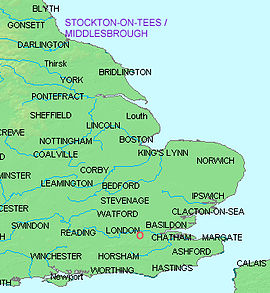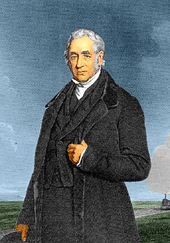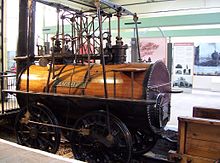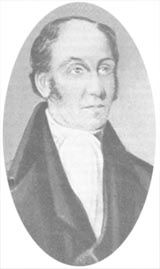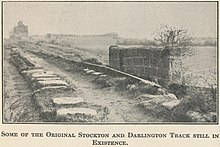Stockton and Darlington Railway
The Stockton & Darlington Railway Company ( S&DR ) was the first public railway to use steam locomotives for freight transport . The line is also of particular importance for the history of the railway because its track gauge of 1435 mm was subsequently used as standard gauge for most railways worldwide . The Legend beside According to the 1435 mm track should on the spacing of the wheel ruts of up to England's leading long-distance routes of the Roman Empirebased. In fact, however, care was taken to ensure that the Stockton and Darlington Railway's tracks also allowed the use of horse-drawn carriages for passengers and coal wagons that used the older driveways to the surrounding coal mines. This seems to be the main reason that the 4ft-8-½ or 1435-mm dimension was adopted and later spread as the standard gauge due to the manufacturing process.
The 40-kilometer route in north-east England connected the coal mines around Bishop Auckland with the towns of Shildon , Darlington , Stockton-on-Tees and later also Port Darlington, today's Middlesbrough . The railway existed from 1825 to 1863 as an independent company and then merged into the network of larger railway companies .
history
Transporting coal in north-east England in the 19th century
At the end of the 18th century, during the course of industrialization in England , there was an increasing need for coal for the newly emerging steam engines , for smelting ore and, last but not least, for heating houses in London and other large cities. Well exploitable coal deposits were found in northeastern England and especially in the counties around the River Tees and Stockton-on-Tees .
Since the Middle Ages , the coal has been brought to the rivers on horses , from there to be shipped mainly to London. In the sixteenth century there were hundreds, possibly even thousands, of pack horses roaming the county at all times. The horses initially carried the coal in side panniers, later the coal was also loaded onto carts . Transportation by heavy carts in the moisture-soaked earth of north-east England was arduous, however. As a result, “tramroads” soon arose here for freight traffic , on which a horse could pull a ton of coal over nine to ten miles in a day. These “tramroads” consisted of a track sunk into the ground, lined with wooden planks, in which the wagon wheels ran easier than on bare ground.
The scale of these transport deals economically favored the regions and places that were involved. Naturally, competition developed between the surrounding places and those who did not have a geographical advantage, for example with a well-located port, tried to influence these transport flows in their favor. So citizens of Stockton-on-Tees planned a canal from their city to Evenwood am Gauge , the " Stockton and Auckland Canal ". This was intended to promote coal transports from the mines in County Durham and, of course, to collect fees.
Local rivalries - Canal or “Tramroad”?
The proposed canal construction, however, displeased Darlington- based businessmen Edward Pease , Jonathan Backhouse and Francis Mewburn . The canal would have missed her hometown and the surrounding coal mines by 13 kilometers. They therefore campaigned for the construction of a "tramroad" that should lead from the mines around Bishop Auckland via Darlington to Stockton.
Even at that time, England was so densely populated that roads and transport routes inevitably ran over private land or in a disruptive manner in their vicinity. New transport routes therefore also required parliamentary approval. The group around Pease decided on November 13, 1818, to apply for the necessary parliamentary act for the construction of the "tramroad" (German about: " Huntstrasse "). With more favorable proof of capital and cost calculations, Pease initially succeeded in presenting the idea of building a railway line more convincingly than the competing canal project. They lost this and another approval procedure before the British Parliament , however, mainly due to the resistance of Lord Darlington, who feared for his fox-hunting areas.
The Darlington Committee wanted to appear before Parliament again in 1820 with a new route. The death of King George III. on January 29, 1820 and the subsequent election of parliament, however, did not allow the petition until 1821. The route redesigned by George Overton comprised 37 miles with five branch lines. On April 12, 1821, the petition was approved by the House of Commons and on April 17 by the House of Lords . She received royal approval from George IV on April 19 .
The permit stipulated, among other things, that anyone could drive a railroad car on the route, provided they paid the fees and used safe equipment. Operation was permitted between 7 a.m. and 6 p.m. in winter and between 5 a.m. and 10 p.m. in summer. However, the main purpose of the coal transport was not mentioned, nor was it possible to carry passengers . Around 1828, however, the regular transport of people in a horse-drawn carriage (total capacity 16 passengers) is documented.
George Stephenson and the "Railway"
While Pease was waiting at home in Darlington on the evening of April 19, 1821 for the decisive news from London, the manager of the Killingworth colliery , Nicholas Wood , and his engineer George Stephenson called on him. It is anecdotal that Stephenson entered Pease's house barefoot. However, it is disputed whether Stephenson hiked barefoot to Darlington to protect his shoes, or whether he took off his shoes in front of his house out of respect for the influential Pease.
Stephenson suggested to Pease to build a railway with locomotives instead of the "tramroad" . Stephenson stated that "a horse on an iron road would pull 10 tons compared to a ton on a normal road". He added that the locomotive Blücher built by him in Killingworth was "worth fifty horses".
Pease visited this machine in the Killingworth colliery and on July 23, 1821 reported to the committee members of its impressive performance. Thereupon it was decided to build a “railway” instead of the “tramroad”. Against the resistance of some committee members, Pease also got through that the route would be redefined by Stephenson. Stephenson presented the results of his investigations on January 18, 1822 and four days later received a permanent position and the contract to build the railway. He was paid at £ 660 a year.
Later it turned out that Stephenson had difficulties building the locomotives in time. Pease therefore even considered giving the locomotives to another company in Leeds . Paradoxically, the problem for Stephenson and his collaborating son Robert was that they were too successful in the "railroad bug" now breaking out in England. They were considered leaders in their field and took on orders for many new rail projects. George Stephenson took on an advisory role in four other railway projects and his son Robert quickly traveled to South America , where he took a position as an engineer at the Columbian Mining Association and spent the next three years working mostly in Venezuela and Bolivia .
In the meantime, the committee sought parliamentary approval for the route changed by Stephenson and received the corresponding Amending Act on May 23, 1823. Lord Darlington again objected to this, but this was now rejected. The document also contained permission to collect a fee of 6 shillings per mile from anyone who wanted to drive a vehicle with passengers on the route. This is the first time that the idea of transporting people on rails is proven. But it was even more important that operation with a self-propelled tractor unit was also approved.
Construction of the railway line
For the construction of the line, 64,000 stone sleepers with a wooden substructure were laid. The stone sleepers had holes in pairs for the nails with which the rails were attached to the wood through the stone layer. These first sleepers, however, based on the "tramroad", were still used in such a way that they ran lengthways under the rails. The more sensible arrangement across the track with more stable tracking was only introduced a few years later.
Also based on the “tramroads”, the rails were laid at a distance of four feet and eight and a half inches (1435 mm), which subsequently became the most widespread rail gauge in the world, primarily thanks to George and Robert Stephenson's involvement in the first railroad construction or the standard gauge (or standard gauge) was.
On May 23, 1822, committee chairman Thomas Meynell ceremonially laid the first steel rail on the sleepers near St John's Well in Stockton. By the summer of 1823, 22 of the 26 miles of rails had been laid. The swampy land between Heighington and Darlington, where the rails kept sinking despite the tons of heaped ground, was difficult to cope with. The iron Gaunless Bridge , completed in October 1823, was badly damaged by severe flooding and had to be replaced the following year.
Another difficulty in the construction was the cast iron , which up until this point was normally used as a rail. It was heavy and, above all, too brittle for the stress of rolling iron wheels. Stephenson switched to rollable iron in good time, however, and moved the committee to place an order for £ 14,000 with the Bedlington Iron Works for the production of rolled rails. To convince the committee, Stephenson waived the £ 500 that he would have been entitled to as a patent holder for the forging process. This broke his friendship with the co-patent holder William Losh , who saw this as a fraud. The problem was that Stephenson lost the previous builder of his locomotives at the Killingworth colliery as a partner. With the financial support of Pease, George Stephenson and his 19-year-old but very well educated son founded the " Robert Stephenson and Company Limited " to build locomotives. On November 7, 1823, the Committee for the Stockton and Darlington Railway gave this company the first order for four stationary tractors to be used on the slopes at Brusselton and Etherley .
Since Stephenson was unable to complete this machine on time, the difficulties brought old opponents back on the scene who had previously tried unsuccessfully to prevent parliamentary approval. Even one of the company's own shareholders, a Mr. Rowntree, asked for and got compensation because the proposed railway line would make his nearby house uninhabitable, he said.
The first trip with the locomotive
Since Stephenson was apparently unable to complete the promised locomotive on schedule in view of his wide range of activities, Pease appointed Michael Longbridge, the owner of the Bedlington Iron Works, over Stephenson's head in 1824 as the executive engineer for the Robert Stephenson and Co. Longbridge, however, was unable to to cope with the problems of building the locomotives.
In April 1825, however, the approval process for the Liverpool and Manchester Railway , one of Stephenson's projects, fell through in the House of Commons, and Stephenson was suddenly free to work in his factory again and was able to run Locomotion No. 1 complete. It was dismantled into parts on September 16, 1825 and transported by horse-drawn carriage to the Aycliffe Village train station, where it was assembled and put on the rails. Test drives took place on September 26, 1825, followed by the maiden voyage on the following September 27.
The train consisted of 36 wagons , twelve of which were loaded with coal and flour , six with guests and fourteen with workers . The train also had a specially built passenger car called the "Experiment". Pease, the Stephensons, and other guests sat in this car that had 18 seats. Since it had no suspension , the ride in it must have been very uncomfortable. The passenger car is considered the first of its kind, although the steam locomotive Catch me who can 1808 had already carried passengers .
At the Brusselton-Höhe between West Auckland and Shildon , the train began its journey with the participation of thousands of spectators. Hitched to a 1.2 mile long rope, the train was first pulled up the hill by the stationary machines and then lowered again half a mile. Then the train was hooked to the locomotive on which George Stephenson's brother James was at the levers. At first there were several unforeseen stops because a car repeatedly jumped off the rails and had to be taken down. Another stop had to be made due to a lack of steam due to a blocked pipe. George Stephenson worked 35 minutes to remove a piece of old rope from the pipe.
This first nine-mile drive from Brusselton to Darlington took two hours. The further journey to Stockton (20 miles from Brusselton) with water replenishment in the meantime took a total of five and three quarters of an hour. On the slope leading to Stockton Station, the train reached a speed of 15 mph (24 km / h). The arrival of the train was greeted with 21 gun salutes in Stockton Harbor.
Timothy Hackworth and the Locomotives
On July 1, 1828, a kettle crash destroyed the Locomotion No 1 at Aycliffe Level (now Heighington ). The machinist John Cree was killed and the water pump Edward Turnbull was crippled, the wreckage covered several fields. Other machines built by Stephenson were the No. 2, Hope , (November 1825), No. 3, Black Diamond (April 1826), and No. 4, Diligence (May 1826). Two of them also shattered and were initially turned off. The company therefore lacked operational locomotives. The vehicle material was also described as being in very poor condition.
To ensure the maintenance of the machines, Pease hired Timothy Hackworth , the man who had already built William Hedley's Puffing Billy locomotive . Stephenson had previously offered him half his salary if he worked for him. However, since Hackworth wanted to remain independent, the committee set up a workshop for him with 20 workers next to his apartment in Shildon.
Hackworth rebuilt the exploded Locomotion No 1 and made a significant contribution to its successful use - it drove a total of 25,000 miles. After several derailments in 1837 and 1839, the basically immature machine was decommissioned in 1841. From 1857 to the 1880s, she was in a building of the repair shop of Alfred Kitching near Hopetown Carriage Works issued the railway company and from 1892 to 1975 on one of the platforms of the main railway station in Darlington, until they in the North Road Railway Museum in was brought to North Road Station from Darlington, where it can be visited to this day. Stephenson's other wrecked machines were also put back into operation by Hackworth in his Shildon workshop.
Since Stephenson's locomotives were so weak and unreliable, their builder even started to build so-called “dandy cart” cars. With a heavy load, these could easily be pulled up the slope by horses. At the apex of the slope, the horses could be unharnessed and loaded into one of the wagons, in which they rolled down the slope with the other wagons. Provided with food during the descent, they could be refreshed again on the next incline in front of the wagon.
While the railway owners had doubts about the concept of the locomotives, only Timothy Hackworth continued to believe in it. After he gave a credible assurance that he could solve all the problems, the shareholders gave him permission to build a new machine in the workshop in Shildon. In the meantime, Hackworth had already started building three machines in his spare time that he believed would perform better than Stephenson's machines. In 1827 he completed the six-wheeled Royal George . It had twice the heating surface compared to Stephenson's machines and a device that released the steam from the cylinders into the chimney and thus effectively fanned the furnace. Stephenson's brother John admired it as the "best machine in the world". It now seemed to confirm the company's expectations of locomotives. But in March 1828 the Royal George also blew up and was taken to Shildon to be rebuilt. Overall, Hackworth apparently contributed significantly more to the successful machine operation of the Stockton and Darlington Railway than the more famous Stephenson.
Contract basis and horse-powered passenger transport
The Stockton and Darlington Railways Company was meanwhile also heavily indebted, the economically necessary operations on the branch lines to the mines at Coundon and to Croft could not be started. Compensation payments even had to be made to the owners of the Coundon mines because they continued to use horse-drawn carts to bring their coal to the already completed railway line.
To a large extent, the company therefore operated its business on a single contract basis. The machinists of the locomotives were allowed to collect a farthing for the ton of coal carried per mile , but had to use this money to pay for the firing, oil and hiring a heater themselves .
Passenger transport was not part of the original operating concept. In view of the financial problems, however, the passenger car Experiment was rented for 200 pounds a year to Richard Pickersgill, who let the car ride on the rails with a harnessed horse and operated a passenger service. Pickersgill had twelve additional seats built on the roof of the car. Other entrepreneurs followed, and operated from July 1826 Martha Howson and Richard Scott two carriages called Defense and Defiance on the line. In October 1826, The Union , a particularly elegant “rail carriage”, began its journey.
The Union owner had his carriage stopped at the pubs along the line and other carriage operators soon followed suit. This closeness to alcohol soon turned out to be a problem. While the horse-powered carriages had to give way to the locomotive-powered trains, they were treated equally when they met on the rails. Since there were no rules, the right of way was argued over and over again, sometimes for hours. The alcohol consumed in the process could induce both passengers and the coachmen to violently remove the opposing passengers and the car from the rails. However, it also happened that the superior team dismounted after a victorious pass and helped the defeated group back on the rails.
There was no limit to the number of people in the carriages, so the Defense carriage was once occupied by 46 people, only nine of whom were inside. Some of the rest were sitting around the edges of the roof, others were standing in a huddled group on the roof and the rest were clinging to anything that offered any support.
"Port Darlington" - the first "railway town"
By 1830 the S&DR had a route network with four branch lines and over 45 miles in length. The most important line was that to Stockton Harbor, but it often proved too shallow and distant for the increasing number of coal shipments. The Darlington pioneers therefore planned an extension to the Salt Marshes of Middlesbrough from 1827 . In 1828 they applied to parliament for approval and had to fight hard against the port owners of the Tyne and the Wear . There was trouble within society too, Leonard Raisbeck from Stockton, a lawyer from the very beginning, and Chairman Thomas Meynell from Yarm withdrew because they feared disadvantages for their cities. So the S&DR became a society dominated purely by the Darlington Group and the Pease family. After numerous disputes, the line towards Middlesbrough could be tackled in November 1829.
Edward Pease's son Joseph made the business of his life here. Together with the Quakers Joseph Pease, Thomas Richardson, Henry Birbeck, Simon Martin and Francis Gibsonvier from London and Norwich , he bought the Middlesbrough Estate, 520 acres (2.1 km²) salt marshes, from William Chilton in 1829 for about 30,000 pounds . These "Middlesbrough owners" began to build a port here, which they - much to the annoyance of the Stocktoners - called "Port Darlington".
A suspension bridge was built over the Tees at Stockton , but it proved so weak that only groups of four cars could drive over the bridge at a distance of nine feet. In 1844 the bridge was replaced by another construction by Robert Stephenson. The coal that arrived after crossing the bridge was loaded into the barges by steam cranes designed by Timothy Hackworth. At 10 a.m. on December 27, 1830, the first coal train crossed the bridge to Port Darlington with guests of honor. This day is considered to be the birth of what would later become the " railway town " of Middlesbrough.
Stabilization and streamlining
In 1832, eight years after starting operations, the S&DR had 19 locomotives, all of which were operational thanks to the skills and dedication of Timothy Hackworth. Between Brusselton (west of Darlington) and Stockton, the railway even ran two tracks to cope with the volume of traffic.
But there was still one big problem - the horses and their owners. The S&DR was a public institution and owned the rail system, but anyone was allowed to use the rails provided they paid the fees and complied with the rules. The S&DR itself only operated the coal trains and left the passenger service to other companies. These were often also the hosts of the pubs that served as stops. This led to "anarchy" on the rails. On March 1, 1832, two drunken horse drivers refused to drive into the siding in front of the William IV locomotive , not only laid a rail and a seat over the track, but also jumped on the locomotive and violently attacked the machine personnel. It was also not uncommon for horse-handlers to leave their horses and wagons on the rails and disappear into a nearby pub to drink. On one such occasion, for example, the Globe locomotive rammed an unlit car on the rails at Aycliffe Lane.
In August 1833, a number of horse-drawn carriage owners were found guilty of not having correctly reported the journeys in order to save fees. In doing so, they provided the S&DR committee with the long-awaited reason to quit. In October the S&DR bought out the contractors for £ 316, 17 shillings and 8 pence. The concept of the “Public Way” was thus over. The railway company could now dispose of its own rails, for which it had already taken steps with foresight. Hackworth had been instructed as early as 1829 to build a high-speed locomotive for passenger service.
The machines for transporting coal were heavy and slow, which was not initially considered a disadvantage, as the additional horse operation on the rails did not allow for a faster journey. Hackworth then built the aforementioned Globe in Robert Stephenson's workshop in Newcastle upon Tyne . She is said to have possessed light wooden wheels and reached a speed of just under 50 mph. The machinist stood in the wooden tender for lack of other space . However, the cranked axle for the cylinder arranged between the wheels was considered to be the most revolutionary detail , which led to smooth running at high speed. The construction of the Globe was £ 515. Their first voyage, led by Johnny Morgan, opened the extension to Port Darlington. After the horse handlers were bought out, the Globe was used exclusively in passenger service until, in January 1838, due to a lack of water near Middlesbrough , it suffered a kettle crack .
Takeovers and mergers, today's operations
On July 23, 1858, the Middlesbrough and Redcar Railway (M&RR) , which had only been founded in 1846, was taken over by the S&DR. This railway line stretched for eight miles along the south bank of the Tees River to the town of Redcar further out to sea . Newly discovered iron ore deposits and the idea of a seaside resort prompted S&DR director Henry Pease to extend the line via Redcar to Saltburn on the coast in 1861 . The rails led comfortably to the rear of the Zetland Hotel built there.
On July 13, 1863, the S&DR merged with the North Eastern Railway, which had only been founded a few years earlier from two other railway companies . This was converted into the London and North Eastern Railway (LNER) in 1923 and re-joined the British Railways in 1948 .
The route now known as the Tees Valley Line from Bishop Auckland via Darlington and Stockton-on-Tees to Middlesbrough and from there to Saltburn is still used today as part of the public transport system. Until 2004, rail traffic there was operated by Arriva Trains North , a private railway that is now owned by Deutsche Bahn .
Since 2004, trains operated by Northern Rail , a franchise company of a consortium of the English division of the Nederlandse Spoorwegen , NedRailways , and Serco , an international operator of public transport systems , have been running on the rails every hour and sometimes every half hour . In 2003, this consortium won the tender to operate the north-east England rail network. The Stockton-on-Tees station is also the world's oldest operating train station along the route. Other facilities were partially converted into a railway museum.
literature
- James Stephen Jeans: Jubilee Memorial of the Railway System: History of the Stockton and Darlington Railway. Graham, Newcastle upon Tyne 1974, ISBN 0-85983-050-0 (English)
- Charles Alexander McDougall: The Stockton & Darlington Railway, 1821–1863. Durham County Council, Durham 1975, ISBN 0-904738-00-0 (English)
- Maurice W. Kirby: The Origins of Railway Enterprise. The Stockton and Darlington Railway 1821–1863. Cambridge University Press, Cambridge 2002, ISBN 0-521-89280-5 (English)
- Jakob Schmitz: Aufbruch auf Aktien , Verlag Wirtschaft und Finances, Düsseldorf 1996, ISBN 3-87881-101-2
Web links
- The Northern Echo: History of the Stockton and Darlington Railway (English)
- Northern Rail route map showing the Bishop Auckland - Middlesbrough - Saltburn section
Individual evidence
- ↑ Roman Chariots and Urban Legends ( Memento of August 21, 2010 in the Internet Archive ) (English).
- ^ The Great Western World Heritage Site 2010, page 6: The S & DRs track gauge was required to accommodate the horse-drawn wagons used in the older wagonways serving coal mines. This influence appears to be the main reason that 4ft 8½ was subsequently adopted as standard gauge.
- ↑ Terra X: Victory of the Steam Rocket (TV documentary).
- ^ Railway Traveling. In: The Mechanics' Magazine (and Journal of Engineering, Agricultural Machinery, Manufactures, and Shipbuilding) , February 2, 1828, p. 16 (online at ANNO ).
- ^ Smiles, Samuel: Lives of the Engineers. The locomotive. George and Robert Stephenson . John Murray, 1904, OCLC 220796785 , p. 166 ( archive.org ).
- ↑ Immigration and Emigration to bbc.co.uk .

